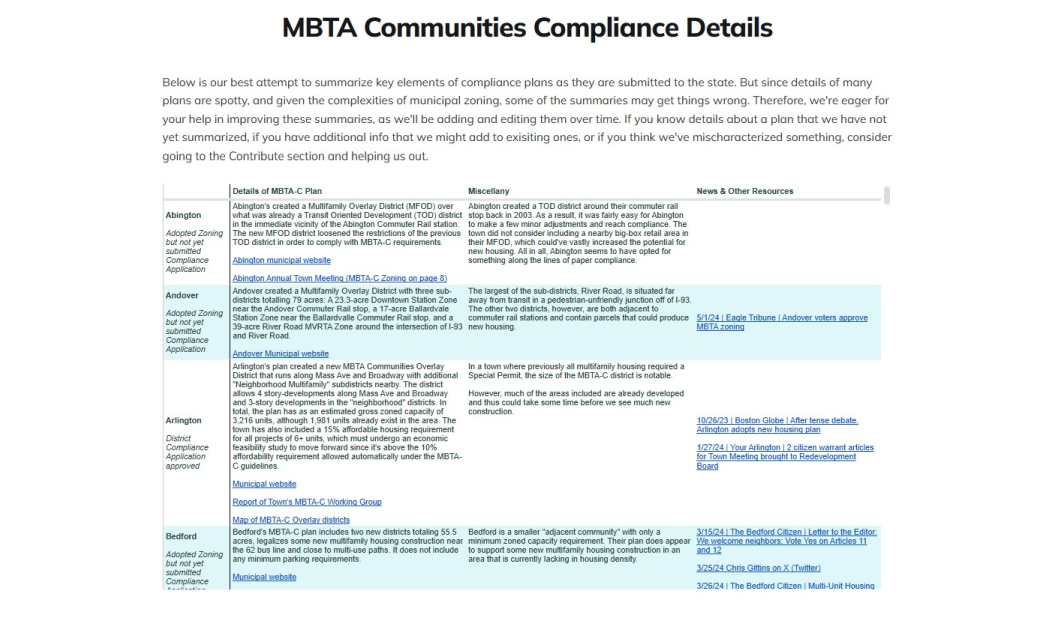New MBTA Communities Tracker
By: Luc Schuster and Lucas Munson
Date: May 20, 2024
Never in the history of zoning have so many Massachusetts municipalities upzoned for multi-family housing, spurred by the MBTA Communities law. But are the plans any good? Which are sincere attempts to welcome new housing, and which comply only on paper? To answer this, Boston Indicators and zoning expert Amy Dain launched Upzone Update in January. The project features biweekly newsletters, each with three parts: cover articles on compliance in MBTA-Communities, a selection of links to local news, and a schedule of local meetings. We send the newsletter to a dedicated Upzone Update email list, so if you’d like to receive those, sign up here.
We’ve now also added a new component, an MBTA-Communities Tracker, our attempt to summarize details of compliance plans that towns submit to the state. Where possible, we’re offering rough interpretations of what housing construction might result in coming years. And we’re compiling links to official documentation and related news coverage.
Since official documentation is spotty and zoning details are complex, many of these summaries will be incomplete. And some may get things wrong. Thus, we're eager for your help improving and adding to them. If you know details about a plan that we have not yet summarized, have more info to add, or think we've mischaracterized something, please let us know by either emailing us at upzoneupdate@bostonindicators.org or going to the “Contribute" section of the Upzone Update website.
Some interesting findings from the work thus far:
- A few Rapid Transit communities had pre-existing zoning that already complied (e.g. Cambridge), or was close (e.g. Malden), so the plans they submitted to the state reflect little change in practice. In one sense this may be fine, as the law was designed to have an equalizing effect, pushing communities that have historically been less welcoming of multifamily housing to level-up. But in another sense, this can feel like a disappointment, as these communities are some of the best-served by transit and could embrace far more density around transit than they currently do. By doing minimum compliance, MBTA-C will not have spurred much more housing in these valuable parts of the region.
- Several other communities, such as Arlington and Newton, have merged their MBTA-C efforts with broader planning processes that would have been happening separately, and the new MBTA-C requirement pushed these planning efforts to reach successful conclusions faster. In these cases, MBTA-C also likely pushed towns to adopt plans that are a bit more pro-housing, such as by making the new zoning by-right, rather than requiring special permit approval.
- A large number of smaller towns have adopted plans ahead of their deadlines. Because the technical details make a big difference—whether it be minimum parking requirements or the specific parcels included—it’s hard to predict how much housing these plans will result in. But in several cases, such as Bedford, Lexington, and Mansfield, the plans do appear to reflect good faith attempts to welcome some additional multifamily home building.
- However, many other communities are either considering or adopting plans that intend to comply in ways that minimize new housing construction. Press coverage of towns like North Andover, Sudbury and Wayland provide details on how each of their plans were largely drawn around parcels with pre-existing multifamily housing. In some instances, the fact that the plans were designed in a way to minimize change is being touted as a selling point at Town Meetings. If more communities adopt this approach, then the impact of the MBTA Communities Law will be reduced.
Check out the Tracker for more details as we gather them. And please sign up for Upzone Update for biweekly analysis of what this all means for the region.

